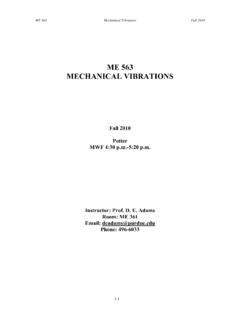Transcription of Stress-Strain Behavior of Thermoplastic Polyurethane
1 1 Stress-Strain Behavior of Thermoplastic Polyurethane Qi1,2, Boyce1,* 1 Department of mechanical Engineering massachusetts institute of technology Cambridge, MA 02139 2 Department of mechanical Engineering University of Colorado Boulder, CO 80309 Submitted in December 2003 Revised in July 2004 Submitted to Mechanics of Materials * Corresponding author. Tel: 1-617-253-2342; fax: 1-617-258-8742 E-mail address: 2 Stress-Strain Behavior of Thermoplastic Polyurethane Qi1,2, Boyce1 1 Department of mechanical Engineering, massachusetts institute of technology Cambridge, MA 02139 2 Department of mechanical Engineering, University of Colorado Boulder, CO 80309 Submitted in December 2003 Revised in July 2004 Abstract The large strain nonlinear Stress-Strain Behavior of Thermoplastic polyurethanes (TPUs) exhibits strong hysteresis, rate dependence and softening. Thermoplastic polyurethanes are copolymers composed of hard and soft segments.
2 The hard and soft segments phase separate to form a microstructure of hard and soft domains typically on a length scale of a few tens of nanometers. Studies have revealed this domain structure to evolve with deformation; this evolution is thought to be the primary source of hysteresis and cyclic softening. In this paper, experiments and a constitutive model capturing the major features of the Stress-Strain Behavior of TPUs, including nonlinear hyperelastic Behavior , time dependence, hysteresis, and softening, are presented. The model is based 3 on the morphological observations of TPUs during deformation. A systematic method to estimate the material parameters for the model is presented. Excellent agreement between experimental results and model predictions of various uniaxial compression tests confirms the efficacy of the proposed constitutive model. Keyword: Softening; Mullins Effect; Stress-Strain Behavior ; Thermoplastic Polyurethane Elastomer; Rubber.
3 1. Introduction The first commercial Thermoplastic polyurethanes (TPUs) were established in Germany by Bayer-Fabenfabriken and in the by Goodrich in the 1950s (Schollenbenger et al., 1958). The Alliance for the Polyurethane Industry (API) describes TPUs as bridging the gap between rubber and plastics , since TPUs offer the mechanical performance characteristics of rubber but can be processed as thermoplastics. This special niche of TPUs among other polymers and elastomers imparts high elasticity combined with high abrasion resistance, and results in a wide array of applications ranging from ski boots and footwear to gaskets, hoses, and seals. HSSSH ydrogen BondHSSSH ydrogen Bond Figure 1: The alternating structure of TPUs. HS: Hard segment; SS: Soft Segment. 4 HDSDHDSD HDSDI solated HSHDSDI solated HS (a) (b) Figure2: Hard domains (HD) and soft domains (SD) of TPUs with (a) a low hard segment content (adopted from Petrovic and Ferguson, 1991); (b) a high hard segment content (adopted from Estes et al.)
4 (1971) and Petrovic and Ferguson (1991)). Isolated hard segments (HS) seen in (b). Figure 3: Transmission Electron Microscope (TEM) image of osmium tetroxide tainted TPU (57% soft segment and 43% hard segment). The light regions are hard domains and the dark regions are soft domains. 5 Thermoplastic polyurethanes are randomly segmented copolymers (Hepburn, 1982) composed of hard and soft segments forming a two-phase microstructure (Figure 1). Generally, phase separation occurs in most TPUs due to the intrinsic incompatibility between the hard segments and soft segments: the hard segments, composed of polar materials, can form carbonyl to amino hydrogen bonds and thus tend to cluster or aggregate into ordered hard domains, whereas the soft segments form amorphous domains. Phase separation, however, is often incomplete, , some of the hard segments are isolated in the soft domains as illustrated schematically in Figure 2(b) (Petrovic and Ferguson, 1991).
5 In many TPUs, the hard domains are immersed in a rubbery soft segment matrix (Wang and Cooper, 1983; Petrovic and Ferguson, 1991). Depending on the hard segment content, the morphology of the hard domains changes from one of isolated domains (Figure 2(a), (Petrovic and Ferguson, 1991)) to one of interconnected domains (Figure 2(b))(Estes et al., 1971; Petrovic and Ferguson, 1991). Using TEM (Transmission Electron Microscope), the interconnected domain structure was verified for the TPU1 used in this research as shown in Figure 3. The domain size in Figure 3 is 10~20nm, which is consistent with observations on various other TPUs ( , Cooper and Tobolsky, 1966; Koutsky et al., 1970; Chen-Tsai et al., 1986). For instance, Koutsky et al. (1970) observed a domain size of 3nm~10nm for a polyester-based Polyurethane and 5nm~10nm for a polyether-based Polyurethane ; Chen-Tsai et al. (1986) observed a hard domain length scale of about 11nm with inter-domain distance of 13nm for a PBD/TDI/BD-based Polyurethane .
6 The presence of hard domains in segmented polyurethanes is very important to the 1 The provider of the sample would prefer the composition of the material unrevealed. 6 mechanical properties. In segmented polyurethanes, hard domains act as physical crosslinks, playing a role similar to chemical crosslinks in vulcanizates and imparting the material s elastomeric Behavior . Since hard domains also occupy significant volume and are stiffer than soft domains, they also function as effective nano-scale fillers and render a material Behavior similar to that of a composite (Petrovic and Ferguson, 1991). At room temperature, soft domains are above their glass transition temperature and impart the material its rubber-like Behavior ; hard domains are below their glassy or melt transition temperature and are thought to govern the hysteresis, permanent deformation, high modulus, and tensile strength.
7 The domain structure also imparts TPUs versatility in mechanical properties. A wide variety of property combinations can be achieved by varying the molecular weight of the hard and soft segments, their ratio, and chemical type. For instance, TPUs with shore hardness of from 60A to 70D are available (Payne and Rader, 1993). At present, Thermoplastic polyurethanes are an important group of Polyurethane products because of their advantage in abrasion and chemical resistance, excellent mechanical properties, blood and tissue compatibility, and structural versatility. Here, the mechanical Behavior of a representative TPU is studied in a series of compression tests probing the time-dependent and cyclic loading effects on the large strain deformation Behavior . A constitutive model for the observed Stress-Strain Behavior is then developed and compared directly to experimental data. 2 Stress-Strain Behavior The Stress-Strain Behavior of TPUs demonstrates strong hysteresis, time dependence, and cyclic softening.
8 In this section, a series of uniaxial compression tests are conducted to 7 quantitatively identify these features. mechanical Test Descriptions Uniaxial compression tests were conducted using a computer controlled servo-hydraulic single axial test machine, Instron model 1350. The sample material was a Thermoplastic Polyurethane with durometer hardness value of 92A immediately after production and about 94A after 1 year of shelf life at room temperature. Sheets of material of about 3mm in thickness were cut into cylinders of about 12mm diameter using a die cutter. To eliminate potential buckling, the sample height to diameter ratio was set to be less than 1. In addition, to reduce the contribution of friction due to the interaction with the compression platens, Teflon sheets were placed between the sample and the platens and the initial height/diameter ratio were set to be greater than Specimens were subjected to constant true strain rate loading-unloading cycles and the true stress vs.
9 True strain curve was documented for each test. True strain was defined as the logarithm of the compression ratio determined as the current height over the initial height, where the current height of the sample was monitored during testing using an extensometer. Height measurements were used to form a feedback loop with the actuator to define and control the displacement history such that constant true strain rate conditions were achieved. True stress was obtained by multiplying nominal stress by the compression ratio (Smith, 1974; Petrovic and Ferguson, 1991), assuming the material incompressible2. 2 Elastomers are generally incompressible. DSC (Differential Scanning Calorimeter) tests on the sample used in this paper showed that the glass transition temperature was about -40 C and the melting 8 TPU samples exhibited a certain amount of permanent set after each loading-unloading cycle.
10 The dimensions (diameter and height) of the samples were measured after each loading-unloading cycle to ensure that the true stress-true strain curves always started from the new unloaded specimen height for each cycle. The measurement of the dimensions took about 2~3 minutes, including re-positioning the sample on the compression platen and replacing the Teflon sheets whenever necessary. Hysteresis Figure 4 shows the axial compression true stress-true strain Behavior of two fresh samples loaded to two different maximum strains, and , respectively. The loading curves show an initially stiff response, followed by rollover to a more compliant Behavior at a strain of about , and stiffen again after a strain of The unloading paths show a large hysteresis loop with a residual strain. Additional recovery occurred with time after unloading. Residual strains were measured approximately 1 minute after the tests and were found to be for the test, and for the test.















